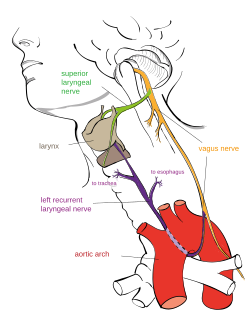Anatomy and Function of the Recurrent Laryngeal Nerve
- The recurrent laryngeal nerve is a branch of the vagus nerve.
- It innervates the muscles responsible for vocal cord movement.
- The left recurrent laryngeal nerve loops around the aortic arch.
- The right recurrent laryngeal nerve loops around the subclavian artery.
- Injury to the recurrent laryngeal nerve can lead to vocal cord paralysis.
- The recurrent laryngeal nerves control all intrinsic muscles of the larynx except for the cricothyroid muscle.
- These muscles open, close, and adjust the tension of the vocal cords, including the posterior cricoarytenoid muscles that open the vocal cords.
- The nerves carry sensory information from the mucous membranes of the larynx and fibers to the cervical segments of the esophagus and trachea.
- The interarytenoid muscle is innervated from both sides of the body.
- Injury to the recurrent laryngeal nerves can result in hoarseness or loss of voice, and may affect the respiratory tract.
Causes and Diagnosis of Recurrent Laryngeal Nerve Injury
- Thyroid surgery is a common cause of recurrent laryngeal nerve injury.
- Other causes include esophageal surgery and lung cancer.
- Intraoperative neuromonitoring can help prevent nerve injury during surgery.
- Visual identification of the nerve is another method used to prevent injury.
- Laryngeal ultrasonography can be used to assess vocal cord function.
- Fiberoptic laryngoscopy allows direct visualization of the vocal cords.
- Electromyography can measure the electrical activity of the vocal cord muscles.
- Voice analysis can help detect changes in voice quality.
- Imaging techniques such as CT or MRI can identify structural abnormalities.
Treatment Options for Recurrent Laryngeal Nerve Injury
- Voice therapy can help improve vocal cord function.
- Injection laryngoplasty can be used to improve vocal cord closure.
- Thyroplasty involves surgical modification of the laryngeal cartilage.
- Nerve reinnervation procedures can restore vocal cord function.
- In severe cases, a tracheostomy may be necessary to ensure adequate breathing.
Complications and Prognosis of Recurrent Laryngeal Nerve Injury
- Aspiration pneumonia can occur due to impaired swallowing.
- Chronic cough and throat irritation are common symptoms.
- The prognosis for recurrent laryngeal nerve injury depends on the cause and severity.
- Early diagnosis and treatment can improve outcomes.
- Long-term follow-up is important to monitor vocal cord function.
Other Topics Related to the Recurrent Laryngeal Nerve
- The right inferior laryngeal nerve is nonrecurrent in some individuals.
- A left nonrecurrent inferior laryngeal nerve is even more uncommon.
- The recurrent laryngeal nerve may be compressed by tumors, particularly in lung cancer patients.
- Ortners syndrome, or cardiovocal syndrome, is a rare cause of left recurrent laryngeal nerve palsy.
- Equine recurrent laryngeal neuropathy is a disease that affects horses, causing progressive paralysis of the larynx.
- Dogs can also experience bilateral recurrent laryngeal nerve disease, which may cause wheezing.
- The recurrent laryngeal nerve can be affected by various other diseases and conditions, leading to nerve injury and related symptoms.
- The detour of the recurrent laryngeal nerves in giraffes is cited as evidence of evolution.
The recurrent laryngeal nerve (RLN) is a branch of the vagus nerve (cranial nerve X) that supplies all the intrinsic muscles of the larynx, with the exception of the cricothyroid muscles. There are two recurrent laryngeal nerves, right and left. The right and left nerves are not symmetrical, with the left nerve looping under the aortic arch, and the right nerve looping under the right subclavian artery then traveling upwards. They both travel alongside the trachea. Additionally, the nerves are among the few nerves that follow a recurrent course, moving in the opposite direction to the nerve they branch from, a fact from which they gain their name.
| Recurrent laryngeal nerve | |
|---|---|
 Course of the left recurrent laryngeal nerve | |
 | |
| Details | |
| From | vagus nerve |
| Innervates | larynx posterior cricoarytenoid lateral cricoarytenoid arytenoid thyroarytenoid aryepiglottis esophagus heart trachea inferior pharyngeal constrictor muscle |
| Identifiers | |
| Latin | nervus laryngeus recurrens |
| MeSH | D012009 |
| TA98 | A14.2.01.166 |
| TA2 | 6344 |
| FMA | 6246 |
| Anatomical terms of neuroanatomy | |
The recurrent laryngeal nerves supply sensation to the larynx below the vocal cords, give cardiac branches to the deep cardiac plexus, and branch to the trachea, esophagus and the inferior constrictor muscles. The posterior cricoarytenoid muscles, the only muscles that can open the vocal folds, are innervated by this nerve.
The recurrent laryngeal nerves are the nerves of the sixth pharyngeal arch. The existence of the recurrent laryngeal nerve was first documented by the physician Galen.
recurrent laryngeal nerve (plural recurrent laryngeal nerves)